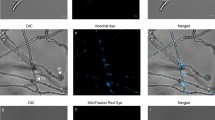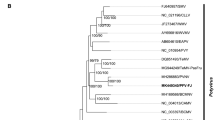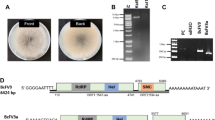Abstract
A DnaJ-like gene, Cpdj1, a molecular chaperone and regulator of Hsp70 in Cryphonectria parasitica, was characterized. The protein product of Cpdj1 gene consists of 379 amino acids with a predicted molecular mass of 40.6 kDa and a pI of 7.79. The deduced protein sequence revealed preservation of the conserved hall-mark J-region and exhibited high homolo y to all known DnaJ-like proteins. Disruption of the Cpdj1 gene resulted in slow growth and produced colonies characterized by retarded growth and deep orange color. Accordingly, reduced virulence of the Cpdj1-null mutant was observed. This reduced growth rate was magnified when the Cpdj1-null mutant was cultured under heat-stress conditions. Reduced conidiation was also observed in the Cpdj1-null mutant, indicating that Cpdj1 gene, although not essential for cell viability, is required for appropriate cellular processes including growth and sporulation. Northern analysis showed that Cpdj1 was constitutively expressed, and when the culture was subject to high temperature, a strong induction of the transcript was observed. No significant difference in the expression and induction pattern of Cpdj1 was observed between virus-free EP155/2 and virus-infected hypovirulent UEP1 strains. However, further severe defects in mycelia rowth and conidiation were observed in the hypovirus-infected Cpdj1-null mutant suggesting that the presence of Cpdj1 is required for mycelia growth and sporulation of the hypovirus-infected strain.
Similar content being viewed by others
References
Allen, T.D., Dawe, A.L., and Nuss, D.L. (2003). Use of cDNA microarrays to monitor transcriptional responses of the chestnut blight fungus Cryphonectri parasitic to infection by virulenceat-tenuating hypoviruses. Eukaryot. Cell 2, 1253–1265.
Allen, T.D., and Nuss, D.L. (2004). Specific and common alterations in host gene transcript accumulation following infection of the chestnut blight fungus by mild and severe hypoviruses. J. Virol. 78, 4145–4155.
Anagnostakis, S.L. (1982). Biological control of chestnut blight. Science 215, 466–471.
Atencio, D.P., and Yaffe, M.P. (1992). MAS5, a yeast homolog of DnaJ involved in mitochondrial protein import. Mol. Cell. Biol. 12, 283–291.
Caplan, A.J., Cyr, D.M., and Douglas, M.G. (1992). YDJ1p facilitates polypeptide translocation across different intracellular membranes by a conserved mechanism. Cell 71, 1143–1155.
Choi, G.H., and Nuss, D.L. (1990). Nucleotide sequence of the glyceraldehyde-3-phosphate dehydrogenase gene from Cryphonectria parasitica. Nucleic Acids Res. 18, 5566.
Choi, G.H., Larson, T.G., and Nuss, D.L. (1992). Molecular analysis of the laccase gene from the chestnut blight fungus and selective suppression of its expression in an isogenic hypovirulent strain. Mol. Plant-Microbe Interact. 5, 119–128.
Choi, E.S., Chung, H.J., Kim, M.J., Park, S.M., Cha, B.J., Yang, M.S., and Kim, D.H. (2005). Characterization of the ERK homologue CpMK2 from the chestnut blight fungus Cryphonectria parasitica. Microbiology 151, 1349–1358.
Chromy, L.R., Pipas, J.M., and Garcea, R.L. (2003). Chaperone-mediated in vitro assembly of Polyomavorus capsids. Proc. Natl. Acad. Sci. USA 100, 10477–10482.
Churchill, A.C.L., Ciufetti, L.M., Hansen, D.R., Van Etten, H.D., and Van Alfen, N.K. (1990). Transformation of the fungal pathogen Cryphonectria parasitica with a variety of heterologous plasmids. Curr. Genet. 17, 25–31.
Cullen, D., Leong, S.A., Wilson, L.J., and Henner, D.J. (1987). Transformation of Aspergillus nidulans with the hygromycin-resistance gene, hph. Gene 57, 21–26.
Cyr, D.M., Langer, T., and Douglas, M.G. (1994). DnaJ-like proteins: molecular chaperones and specific regulators of Hsp70. Trends Biochem. Sci. 19, 176–181.
Deng, F., Allen, T.D., Hillman, B.I., and Nuss, D.L. (2007). Comparative analysis of alterations in host phenotype and transcript accumulation following hypovirus and mycoreovirus infections of the chestnut blight fungus Cryphonectria parasitica. Eukaryot. Cell 6, 1286–1298.
Dey, B., Caplan, A.J., and Boschelli, F. (1996). The Ydj1 molecular chaperone facilitates formation of active p60v-src in yeast. Mol. Biol. Cell. 7, 91–100.
Elliston, J.E. (1985). Characteristics of dsRNA-free and dsRNA-containing strains of Endothia parasitica in relation to hypovirulence. Phytopathology 75, 151–158.
Fu, Q., Li, S., and Yu, D. (2010). Identification of an Arabidopsis Nodulin-related protein in heat stress. Mol. Cells 29, 77–84.
Gurr, S.J., Unkles, S.E., and Kinghorn, J.R. (1987). The structure and organization of nuclear gene in filamentous fungi. In Gene Structure in Eukaryotic Microbes, J.R. Kinghorn, ed. (Oxford: ILR Press), pp. 93–139.
Greene, M.K., Maskos, K., and Landry, S.J. (1998). Role of the Jdomain in the cooperation of Hsp40 with Hsp70. Proc. Natl. Acad. Sci. USA 95, 6108–6113.
Havir, E.A., and Anagnostakis, S.L. (1983). Oxalate production by virulent but not by hypovirulent strains of Endothia parasitica. Physiol. Plant Pathol. 23, 369–376.
Hu, S.M., Liang, P.H., Hsiao, C.D., and Wang, C. (2002). Characterization of the L399P and R447G mutants of hsc70: the decrease in refolding activity is correlated with an increase in the rate of substrate dissociation. Arch. Biochem. Biophys. 407, 135–141.
Johnson, J.L., and Craig, E.A. (2001). An essential role for the substrate-binding region of Hsp40s in Saccharomyces cerevisiae. J. Cell Biol. 152, 851–856.
Ju, Y.J., Kim, D.H., and Cha, B.J. (2002). Isolation of Cryphonectria parasitica from cankers on chestnut trees in Korea and characteristics of isolates. Plant Pathol. J. 18, 23–29.
Kang, H.S., Choi, J.W., Park, S.M., Cha, B.J., Yang, M.S., and Kim, D.H. (2000). Ordered differential display from Cryphonectria parasitica. Plant Pathol. J. 16, 142–146.
Kazmierczak, P., Pfeiffer, P., Zhang, L., and Van Alfen, N.K. (1996). Transcriptional repression of specific host genes by the mycovirus Cryphonectria hypovirus CHV1. J. Virol. 70, 1137–1142.
Kelly, W.L. (1998). The J-domain family and the recruitment of chaperone power. Trends Biochem. Sci. 23, 222–227.
Kim, J.H., and Kim, D.H. (2006). Cloning and characterization of a thioredoxin gene, CpTrx1, from the chestnut blight fungus Cryphonectria parasitica. J. Microbiol. 44, 556–561.
Kim, D.H., Rigling, D., Zhang, L., and Van Alfen, N.K. (1995). A new extracellular laccase of Cryphonectria parasitica is revealed by deletion of Lac1. Mol. Plant-Microbe Interact. 8, 259–266.
Kim, M.J., Choi, J.W., Park, S.M., Cha, B.J., Yang, M.S., and Kim, D.H. (2002). Characterization of a fungal protein kinase from Cryphonectria parasitica and its transcriptional upregulation by hypovirus. Mol. Microbiol. 45, 933–941.
Kim, M.J., Kwon, B.R., Park, S.M., Chung, H.J., Yang, M.S., Churchill, A.C.L., Van Alfen, N.K., and Kim, D.H. (2008). Promoter analysis of the cell surface-abundant and hypoviral-regulated cryparin gene from Cryphonectria parasitica. Mol. Cells 26, 496–502.
Lee, J.K., Tattar, T.A., Berman, P.M., and Mount, M.S. (1992). A rapid method for testing the virulence of Cryphonectria parasitica using excised bark and wood of American chestnut. Phytopathology 82, 1454–1456.
Lee, D.H., Sherman, M.Y., and Goldberg, A.L. (1996). Involvement of the molecular chaperone Ydj1 in the ubiquitin-dependent degradation of short-lived and abnormal proteins in Saccharomyces cerevisiae. Mol. Cell. Biol. 16, 4773–4781.
Lindquist, S., and Craig, E.A. (1988). The heat-shock proteins. Ann. Rev. Genet. 22, 631–677.
Lu, Z., and Cyr, D.M. (1998). Protein folding activity of Hsp70 is modified differentially by the hsp40 co-chaperones Sis1 and Ydj1. J. Biol. Chem. 273, 27824–27830.
Niewiarowska, J., D’Halluin, J.C., and Belin, M.T. (1992). Adenovirus capsid proteins interact with HSP70 proteins after penetration in human or rodent cells. Exp. Cell Res. 201, 408–416.
Nuss, D.L. (1992). Biological control of chestnut blight: an example of virus-mediated attenuation of fungal pathogenesis. Microbiol. Rev. 56, 561–576.
Orbach, M.J., Porro, E.B., and Yanofsky, C. (1986). Cloning and characterization of the gene for beta-tubulin from a benomyl-resistant mutant of Neurospora crassa and its use as a dominant selectable marker. Mol. Cell. Biol. 6, 2452–2461.
Park, S.M., Choi, E.S., Kim, M.J., Cha, B.J., Yang, M.S., and Kim, D.H. (2004). Characterization of HOG1 homologue, CpMK1, from Cryphonectria parasitica and evidence for hypovirus-mediated perturbation of its phosphorylation in response to hypertonic stress. Mol. Microbiol. 51, 1267–1277.
Park, S.M., Kim, J.M., Chung, H.J., Lim, J.Y., Kwon, B.R., Lim, J.G., Kim, J.A., Kim, M.J., Cha, B.J., Lee, S.H., et al. (2008). Occurrence of diverse dsRNA in a Korean population of the chestnut blight fungus, Cryphonectria parasitica. Mycol. Res. 112, 1220–1226.
Plesofsky, N. (2004). Heat shock proteins and the stress response. In the Mycota III Biochemistry and Molecular Biology, R., Brambl, and C.A., Marzluf, eds. (Berlin: Springer-Verlag), pp. 143–173.
Powell, W.A.J., and Van Alfen, N.K. (1987). Two nonhomologus viruses of Cryphonectria (Endothia) parasitica reduce accumulation of specific virulence-associated polypeptides. J. Bacteriol. 169, 5324–5326.
Rigling, D., Heiniger, U., and Hohl, H.R. (1989). Reduction of laccase activity in dsRNA-containing hypovirulent strains of Cryphonectria (Endothia) parasitica. Phytopathology 79, 219–223.
Roberts, A.N., Berlin, V., Hager, K.M., and Yanofsky, C. (1988). Molecular analysis of a Neurospora crassa gene expressed during conidiation. Mol. Cell. Biol. 8, 2411–2418.
Sambrook, J., Fritsch, E.F., and Maniatis, T. (1989). Molecular cloning: a laboratory manual, 2nd edition, (NY, USA: Cold Spring Harbor Laboratory Press).
Silver, P.A., and Way, J.C. (1993). Eukaryotic DnaJ homologs and the specificity of Hsp70 activity. Cell 74, 5–6.
Sullivan, C.S., and Pipas, J.M. (2001). The virus-chaperone connection. Virology 287, 1–8.
Sun, Q., Choi, G., and Nuss, D.L. (2009). A silencing argonaute gene is required for induction of RNA silencing antiviral defense and promotes viral RNA recombination. Proc. Natl. Acad. Sci. USA 106, 17927–17932.
Tachibana, T., Astumi, S., Shioda, R., Ueno, M., Uritani, M., and Ushimaru, T. (2002). A novel non-conventional heat shock element regulates expression of MDJ1 encoding a DnaJ homolog in Saccharomyces cerevisiae. J. Biol. Chem. 277, 22140–22146.
Walsh, P., Bursac, D., Law, Y.C., Cyr, D., and Lithgow, T. (2004). The J-protein family: modulating protein assembly, disassembly and translocation. EMBO Rep. 5, 567–571.
Walter S., and Buchner, J. (2002). Molecular chaperones-cellular machines for protein folding. Angew. Chem. Int. Ed. Engl. 41, 1098–1113.
Van Alfen, N.K. (1982). Biology and potential for disease control of hypovirulence of Endothia parasitica. Ann. Rev. Phytopathol. 20, 349–362.
Van Alfen, N.K., Jaynes, R.A., Anagnostakis, S.L., and Day, P.R. (1975). Chestnut blight: biological control by transmissible hypovirulence in Endothia parasitica. Science 189, 890–891.
Wang, R.Y., Stork, J., and Nagy, P.D. (2009). A key role for heat shock protein 70 in the localization and insertion of tombusvirus replication proteins to intracellular membranes. J. Virol. 83, 15–22.
Zhang, L., Villalon, D., Sun, Y., Kazmierczak, P., and Van Alfen, N.K. (1994). Virus-associated down-regulation of the gene encoding cryparin, an abundant cell-surface protein from the chestnut blight fungus, Cryphonectria parasitica. Gene 139, 59–64.
Author information
Authors and Affiliations
Corresponding author
About this article
Cite this article
Lim, JG., Lee, JG., Kim, JM. et al. A DnaJ-like homolog from Cryphonectria parasitica is not responsive to hypoviral infection but is important for fungal growth in both wild-type and hypovirulent strains. Mol Cells 30, 235–243 (2010). https://doi.org/10.1007/s10059-010-0112-1
Received:
Revised:
Accepted:
Published:
Issue Date:
DOI: https://doi.org/10.1007/s10059-010-0112-1




